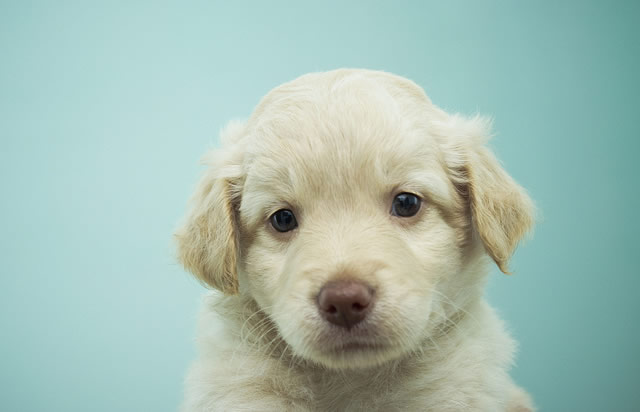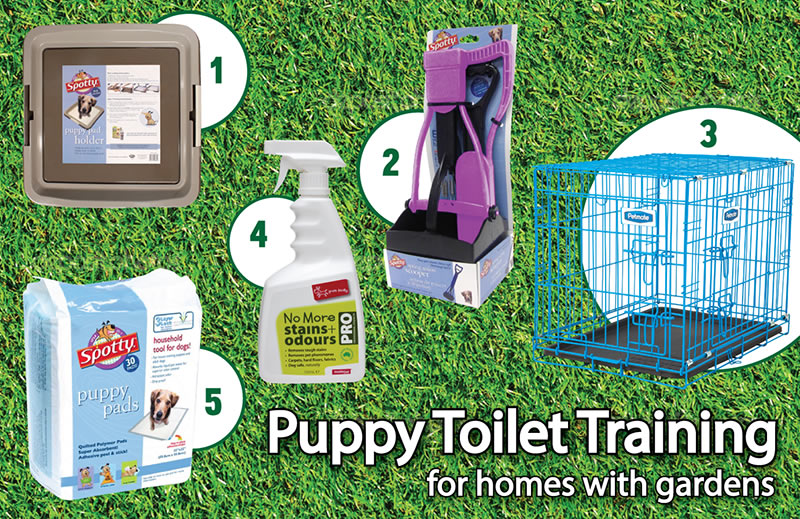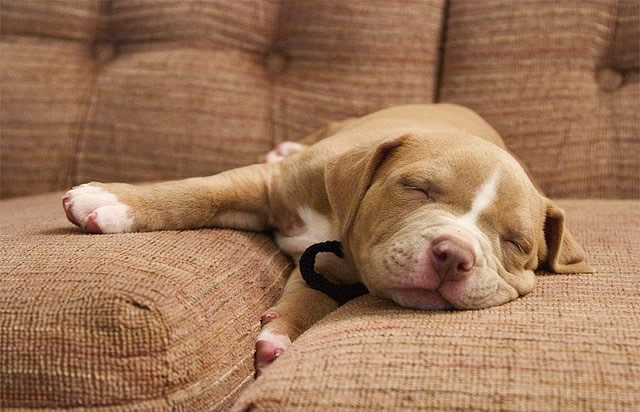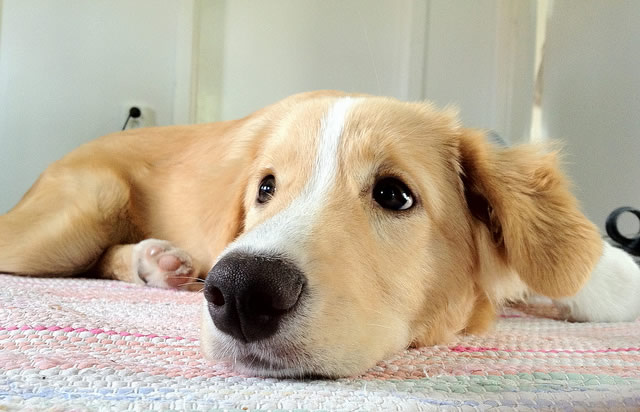When you welcome a little bundle of love into your home, toilet training won’t always be the first thing on your mind. It’s a whirlwind of excitement and in the first few days everything at your house will change.
The sound of tiny paws pattering across the ground, the sweet smell of puppy breath and fuzzy puppy tummies make even the toughest of men melt. Often the usual routine goes out the window but it’s important that you settle into normal everyday life as soon as possible.
We’ve put together this puppy house training guide that features everything you need to know on how to toilet train your puppy quickly.

Image Courtesy of Anderson Rafael - Flickr
When to start toilet training a puppy?
Puppy toilet training should start as soon as their paws step through the door. This will make it easier in the long run as your puppy will know what you expect from them.
According to Cesar Milan, puppies pick up toilet training fairly easily between the ages 8 and 17 weeks because it is part of their natural programming. Click here to tweet
From the moment the puppies are born the mother will lick them to encourage elimination and then will clean it away. This means there is never a scent of urine or faeces in their ‘den’ environment. As the pups grow older they will copy their mother by going to toilet outside of theden.
If your puppy was orphaned then it may take a little more time as they grew up without guidance from their mother or litter mates. You must also remember that if you have a small breed puppy, their bladders and digestive tracts will be smaller than large breeds. This means they can’t hold their pee and poop as well as bigger pups.
But don’t panic! With careful training every single puppy will learn soon enough.
Why is house training puppies important?
It doesn’t matter if your pooch will spend most of their time indoors on your sofa or outdoors in their kennel – all dogs should be toilet trained! House training your puppy has the following benefits as an adult dog:
- They can be trusted to enjoy time inside the house with you.
- They will be able to visit houses of your friends and family members.
- They will learn to eliminate in appropriate places rather than just wherever they feel like it.
- They won’t soil inside your car or travelling crates.
- They won’t poop on the floor when they visit their local store.
- If they do soil inside abnormally you will know to check for health issues such as urinary tract infection or digestive issues.
Puppy toilet training in a home with a garden
The overall goal of toilet training in a home with a garden is to get your puppy to toilet outside. Although young puppies should not be taken for walks before they’ve had their full set of vaccinations, in most cases the garden is fine. If your yard is enclosed and you are sure that no other dogs have entered it then there shouldn’t be any risks involved.
What do I need to toilet train my puppy?

1) Spotty Puppy Pad Holder 2) Spotty Pooper Scooper 3) Petmate Puppy Training Crate 4) Yours Droolly Stain & Odour Cleaner 5) Spotty Puppy Toilet Training Pads
How to toilet train your puppy in a house
- Set regular feeding times for your puppy and keep an eye on when they drink water.
- Every 30 minutes to 1 hour take your puppy outside. Also take them outside immediately after eating and playing.
- Place them in the designated toilet spot, point to the area and say ‘go to toilet’ (or your chosen toilet command phrase).
- Do not play with your puppy or give them any attention whilst you are outside. At the moment you want them to learn that only one thing happens in this circumstance.
- Straight after they have peed or pooped praise them by saying good boy/girl in an appreciative tone and perhaps give them a treat. Be careful not to over feed them.
- Once they have been praised bring them back inside.
Tips
- Every 30 minutes to 1 hour is a rough estimate, your puppy may need to go more or less frequently. Keep an eye out for signals that they need to go. This includes circling, sniffing and wandering out of sight.
- Remember to clean up your puppy’s poops regularly to keep your garden clean. You do not need to leave them there to encourage your puppy to eliminate in the garden.
- If you catch your puppy in the act say ‘No’ sternly and then take them outside to their designated spot. They may or may not have finished toileting but it will reinforce that this is where they should be doing their business.
- You may wish to put down a puppy pad secured in a puppy pad holder near the outside door during training however it is best to monitor your puppy and take them outside since that is eventually where you want them to do their business. Allowing them to go both outdoors and indoors could confuse them.
Puppy toilet training in a home without a garden
Toilet training a puppy in an apartment or a home without a garden poses a set of different challenges. After all, you don’t have a patch of grass outside your door… Say hello to your new best friend – the indoor doggy toilet! Despite the name, it is suitable for indoor and outdoor use so it can fit neatly somewhere in your home or on a balcony/courtyard.
What do I need to toilet train my puppy?

1) Pet Loo 2) Urine Off Cleaner 3) Spotty Dog Poop Bags 4) Petmate Puppy Training Crate 5) Wee Care Pet Loo Cleaner 6) Pet Loo Pee Pods
How toilet train a puppy in an apartment
- Set regular feeding times for your puppy and keep an eye on when they drink.
- Every 30 minutes to 1 hour take your puppy to their indoor dog toilet. Also take them to the toilet after eating and playing.
- Place them on top of the indoor dog toilet, point to the area and say ‘go to toilet’ (or your designated toilet command phrase).
- Do not play with your puppy or give them any attention. You want them to learn that only one thing happens when they are on the doggy toilet.
- Straight after they have peed or pooped praise them by saying good boy/girl in an appreciative tone and perhaps giving them a treat. Be careful not to over feed them.
- Once they have been praised allow them to get off the indoor dog potty.
- If you see your puppy sniffing around the indoor dog potty, praise them as this will encourage them and reduce anxiety. Make sure that they do not play with it or sleep on it like a bed as this is not what it is for.
Tips
- Every 30 minutes to 1 hour is a rough estimate, your puppy may need to go more or less frequently. Keep an eye out for signals that they need to go. This includes circling, sniffing and wandering off out of sight.
- If you catch your puppy going to toilet on the floor say no sternly and then take them to their indoor toilet. They may or may not have finished going but it will reinforce that this is where they should be doing their business.
- Remove your puppy’s poos immediately from the synthetic grass on the dog toilet by scooping them up in a bag. The faeces doesn’t need to be there to encourage your puppy to use the area. It will only cause a bad smell and your puppy might tread in it and spread it across the house.
- It is true that your puppy will recognise their unique scent but it is crucial that you keep your indoor dog toilet clean according to the manufacturer’s instructions.
What to do when leaving your puppy alone
Toilet training should be continued even when you are not home. When your puppy is young they should not be allowed to roam the house freely when you are gone because you are not there to reinforce house training.
If you are popping out and will be gone for only an hour or so, your puppy can remain in their crate (if you choose to crate train your puppy). Put a puppy pad on the base of the floor along with a blanket or small bed and some toys. It will give your puppy a chance to learn how to hold their bladder but be prepared for any mistakes as they are still learning.
If you are going to be gone for longer than an hour you need to confine your dog to a small area of your home such as a bathroom or kitchen. Don’t forget, you can always use an exercise pen to fence off a small section of a room. It is best if this area has solid and non-porous flooring as your puppy is still learning correct toilet behaviour.
Make sure you have the following things available:
- Clean puppy pad secured in a puppy pad holder or your Pet Loo.
- Crate with bedding or a just a dog bed.
- A bowl of water that is not easy to tip over.
- Some safe puppy toys designed for chewing, such as a rubber Kong.
How to toilet train your puppy at night
Firstly you need to decide where you want your dog to sleep. If you want your adult dog to sleep in your laundry, lounge room or in the bedroom with you, this is where your puppy should begin sleeping. If your puppy starts off by sleeping in the room with you it will become very difficult to move them to another location later on.

Image Courtesy of Sparky - Flickr
If you have chosen to crate train your puppy then their crate is the ideal place for them to sleep at night. This is because:
- It is small enough to discourage them from soiling in it.
- They can easily be enclosed to prevent them from wandering of and going to toilet on the floor.
- You’ll be able to hear them when they cry to be let out to do their business.
- The floor of a crate is non-porous and you can easily put a puppy pad down in case of accidents.
If you don’t have a crate you will have to find another way of enclosing them in a safe area, where you can still hear them.
When you first bring your puppy home you should try to set alarms in order to wake up and take them outside or to use their indoor doggy toilet. T to make an effort to take your puppy to toilet twice or three times throughout the night until you are confident that they can hold on until the morning. Most puppies will learn what’s going on very quickly and they’ll wake you up with whining when they need to go!
Dealing with toilet training accidents
Sometimes, when you gotta go, you gotta go! Accidents will happen along the way but if dealt with correctly they won’t set back your puppy’s training. The number one thing to remember isthat positive reinforcement is the only way you should train your puppy and punishing them for having accidents will only make toilet training harder.
Instead of punishing your pup you should ‘punish’ yourself for not paying close enough attention.
If your puppy has an accident -DO NOT:
- Rub the puppy’s nose in it
- Shout or scare the puppy
- Discipline them after it has happened
This is a very old-school method and only teaches your dog that you don’t approve of them toileting in general. Next time they’ll hide their poo or pee behind the sofa or under the bed!
Letting off some steam might make you feel better but it won’t help with toilet training. Plus, it might even damage the bond between you and your pup.
It’s too late and they won’t make the association between you being angry and the mess on the floor.
If your puppy has an accident - DO:
- Let them know they’re doing something wrong
- Ignore the mess
- Clean it up quickly using an enzymatic cleaner
If you see your puppy peeing or pooping in the wrong place, use your voice to sternly tell them off and take them to the designated toilet spot straight away.
This may sound crazy but if you suddenly stumble across a little puddle – ignore it! There’s no point in telling your puppy off after it has happened. Just clean it up and make sure to pay closer attention.
Remove all traces of the accident as soon as possible so that your puppy doesn’t think that it’s okay to go there in the future.
How to clean up puppy urine and faeces
Pet stains are notoriously difficult to remove. Before bringing your puppy home it’s a good idea to grab yourself a speciality pet stain and odour cleaner. Uric acid crystals found in dog urine can only be removed by using an enzyme cleaner.
Other household cleaning products with soap and chemicals aren’t able to remove the stain because they can’t break down the crystals. This is why you need an enzymatic cleaner formulated especially for pet stains when cleaning accidents off the floor.

Image Courtesy of Marthin Sühl - Flickr
The steps below are based on the Urine Free product however most enzyme cleaning products work in a similar way. Please refer to the instructions found on your specific cleaning product before use and always test in an inconspicuous area first.
Non-porous hard flooring
This includes: Glazed tiles, vinyl flooring and slate floors.
- Keep your pet far away.
- Remove waste and/or blot up urine using paper towel or cloth.
- Spray with Urine Free.
- Allow the cleaner to work on the organic matter by letting the product dry.
- Wipe surface with clean, damp sponge to remove residue.
Porous hard flooring
This includes: Hardwood floors, concrete, marble and unglazed ceramics
- Keep your pet far away.
- Remove waste and/or blot up urine using paper towel or cloth.
- Spray with Urine Free.
- Cover with cling wrap to stop it from evaporating whilst it penetrates the porous surface.
- Blot dry with paper towel or cloth.
- Wipe surface with a clean, damp sponge to remove residue.
- Repeat again is stain or odour is still there.
Carpet
- Keep your pet far away.
- Remove waste and/or blot up urine using paper towel or cloth.
- Saturate the soiled area with Urine Free.
- Allow the product to air dry.
- When dry put a small amount of water on the area and blot dry.
Toilet training your puppy needn’t be stressful. Like any other aspect of training, you need to focus on positive reinforcement and always be consistent. This, along with the necessary toilet training equipment will mean your puppy will be housetrained in no time.
Comments
Post a Comment